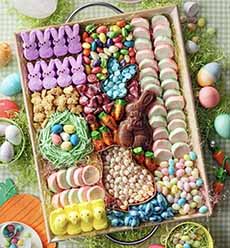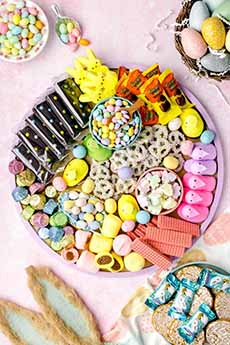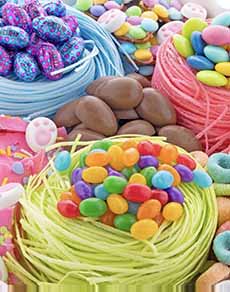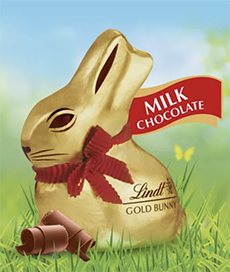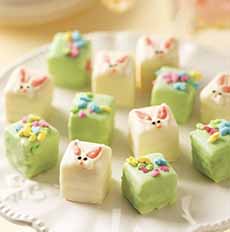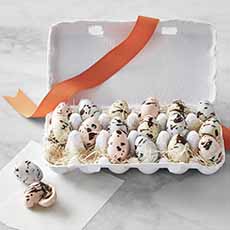Easter Candy Charcuterie Board For An After-Dinner Treat
|
Here’s a crowd pleaser of an idea for Easter dinner: an Easter candy “charcuterie board” (platter) at the end of the meal, instead of petit fours*. Candies and cookies take the place of the meats on an actual charcuterie board†. We serve ours at the end of the meal, after dessert, with coffee. You can either create a platter that’s kid-friendly, or a “gourmet” version for the sophisticated foodie crowd, with artisan Easter candies. You can substitute Easter cookies instead, or combine cookies and candy. If you’re creating an elegant board for connoisseurs, head to your favorite chocolatiers and augment with petite cookies like mini macarons. And you can apply the same principles to a Christmas candy or Valentine candy charcuterie board. It’s an all-celebration concept. And because it’s arranged in advance, you can hide the board from your guests and bring it out as an after-dinner surprise. Thanks to the International Charcuterie Association for inspiring this article. Provide small paper or plastic cups (muffin/cupcake liners work) and serving spoons for people can help themselves. Focus on the color palette (as in the photos) to make your board pop. Check out candies in Easter colors or pastels, or gold or color-foil-wrapped: These are different types of sweets served at the end of a meal with coffee. Liqueurs can also be served. Mignardises (min-yar-DEEZ), from the French for “preciousness,” belong to the group of after-dinner cookies called petit-fours (French for “small baked pastries”). Petit-fours (pronounced petty-foor) are tiny cakes or other tiny baked goods, like mini macaroons and other mini cookies. The words are French for “small ovens” but mean “small baked pastries.” There are many varieties of petit-four; the most familiar in the U.S. is a one-inch-square layered sponge cake, filled with butter cream and iced in a variety of colored fondants, often with tiny roses or other piped embellishments (photo #6). A truly American addition to a petit-fours plate would be mini cupcakes. In France, this style is not common; and there are confections that can be included on a petit-fours plate. See Friandises, below. that are not baked at all. There are two styles of petit-fours: glacée (iced) and sec (dry). Friandises (free-yon-DEEZ), from the French for “delicate,” are another interchangeable term. While some people simply include them under the banner of petit-fours, friandises are actually non-baked confections such as glazed or chocolate-dipped fruit, marzipan, small truffles and other chocolates (e.g. bonbons), marzipan, and nut clusters. > The history of Easter candy and the Easter basket. > The history of the Easter ham. CHECK OUT WHAT’S HAPPENING ON OUR HOME PAGE, THENIBBLE.COM. |
|
|
|
|
||
